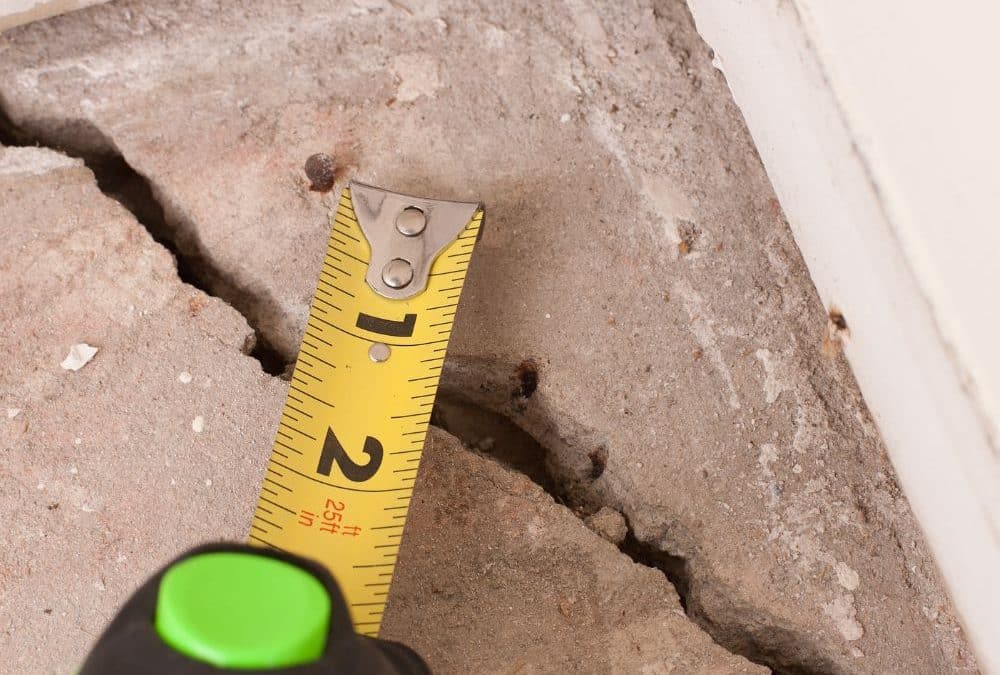A foundation wall crack can be cause for concern for homeowners. Your home’s foundation, crawl space or concrete slab supports your entire house, so any foundation issue might lead to a foundation failure.
If you see a crack, it’s important to first identify the type of crack you have before deciding whether or not it requires further assessment.
To help shed light on the implications of vertical and horizontal cracks in horizontal, we will explore each type below and provide the necessary actions for effective resolution.
There’s no need to panic, but a foundation problem does need to be addressed quickly, so let’s get started.
Vertical vs. Horizontal Cracks in Foundation
The type of foundation crack can signify different structural issues and levels of severity.
You can’t rule out one or the other, though, as both vertical and horizontal cracks can be signs of a serious foundation issue.
What Are Vertical Cracks In Walls?
A vertical foundation crack typically runs straight up and down, running a short distance or the entire height of the foundation wall.
Unlike horizontal cracks, which can be a sign of serious structural damage, vertical cracks are more commonly associated with shrinkage or minor foundation movement.
They often indicate settlement problems or excessive lateral pressure on the foundation.
Even though a vertical crack is usually not as serious, it’s important to monitor vertical cracks closely. You also want to consult with a professional foundation repair expert to assess the extent of the damage and recommend appropriate remediation measures to prevent further deterioration.
This is even more important if the crack is wider than 1/8″ and/or you notice the crack is growing wider.
FYI: You can use the edge of a quarter to measure the thickness of the crack.
What is a Horizontal Crack in the Wall?
Unlike vertical cracks that are typically caused by normal settling, horizontal foundation cracks are usually a sign of lateral pressure from the soil surrounding the foundation or serious settlement issues(common with the expansive clay soil found in Texas).
These cracks can compromise the integrity of the foundation, allowing water seepage and potential collapse if left unaddressed. It is crucial to consult a professional for a thorough inspection and appropriate repairs to prevent further damage to the foundation.
You will need to contact your local foundation repair specialist. If you’re in the San Antonio area, give us a call. 726-227-6380. Houston homeowners can reach out to us at: 713-714-0015
Identify Normal Foundation Cracks Due to Settling
House settling is normal with new construction. Most new buildings will continue to settle, sometimes for years. And this settling can cause hairline cracks that don’t indicate any structural issues.
This settling occurs because of gravity causing the soil to settle back down. And the weight of the building will naturally compress the soil as well. Also, the lumber used in the construction will dry out and shift, causing some settling.
When this happens, you might get some small hairline cracks in the foundation.
Sometimes these cracks can appear in your drywall, or cause slight window/door sticking as well. While an annoyance, these are typically not a cause for concern.
Types of Foundation Cracks
A foundation crack is a crack in the concrete wall that forms your foundation. Cracks can run vertically, horizontally, and what is known as a “stair step crack.” The width of these cracks ranges from thin, hairline cracks to wide cracks large enough to stick your finger into.
Foundation cracks can be deceiving. They sometimes appear as a surface crack, or they can penetrate through the foundation wall. Other cracks might show spalling or crumbling of concrete along the crack.
Cracks often don’t follow an exact straight line and can run in both directions
When we say horizontal or vertical, we are referring to the general movement of the line.
- Horizontal Cracks: A crack in your foundational wall that is running perpendicular to the floor or ceiling.
- Vertical Cracks: A crack in your foundational wall that is running from the floor to the ceiling, or in that direction even if it does not reach the floor or ceiling.
- Diagonal Cracks: A crack that might be between a horizontal or vertical crack running at a diagonal compared to the ceiling or floor.
Are Vertical or Horizontal Cracks Worse?
Foundation cracks are never good, especially since cracked foundations can affect your home’s value.
But when it comes to more serious vertical and horizontal cracks, which is worse?
While both vertical and horizontal cracks can indicate foundation problems, in general, horizontal cracks are worse for your foundation.
A diagonal crack, which is similar to a vertical crack. It is usually not as serious as a horizontal foundation crack. You typically find these near window and door openings.
Should You Worry About a Vertical Crack in the Corner Of the Wall?
A vertical crack in the corner of a foundation wall could signal a potentially serious issue that requires immediate attention. If it continues to widen, this can become a source of concern.
Unlike horizontal cracks that are often caused by pressure from the soil surrounding the foundation, vertical cracks in corners are typically a result of excessive foundation settlement or structural movement.
These diagonal cracks can compromise the integrity of the entire structure, leading to further damage if left untreated. You need to consult with a professional (this is not a DIY repair) sooner rather than later.
They can assess the extent of the damage and determine the most effective course of action for repair to ensure the stability and safety of the building.
Best Repairs to Foundation Cracks
Briefly, there are a number of practices that can be used for foundation crack repair or crawl space repair:
- Filling and sealing vertical cracks in foundation walls.
- Grouting and sealing shrinkage cracks in concrete foundations.
- Resolving foundation settlement issues through underpinning or foundation piering.
- Addressing structural integrity concerns with expert foundation repair solutions.
Final Thoughts on Vertical vs Horizontal Cracks in Foundation
When it comes to identifying foundation issues, understanding the difference between vertical and horizontal cracks is the first step. You will need a professional assessment to determine whether further action is needed.
Vertical cracks typically indicate normal settling, while horizontal cracks can suggest a more serious structural problem requiring immediate attention.
Vertical cracks are usually less severe and can often be addressed through simple repairs, but horizontal cracks often signal a significant issue such as excessive foundation movement that could harm the structural integrity of your home.
Either way, if you have any concerns about your crawl space or concrete slab foundation, it’s important that you call in a foundation specialist before any further damage occurs to the foundation.
This will ensure the structural integrity of the building and your peace of mind.
Call A-Best Foundation Repair to schedule an appointment today!
FAQs Related to Vertical vs Horizontal Cracks in Foundation
Is it safe to live in a house with a cracked foundation?
Living in a house with a cracked foundation can pose serious safety risks, especially if the cracks are extensive or structural in nature. You’ll want to address any foundation problems promptly to ensure the stability and safety of the structure. There are many repair options to resolve the issue.
What is considered a bad foundation crack?
A bad foundation crack is typically wide, jagged, and shows signs of structural compromise, commonly seen in horizontal cracks that indicate a more serious issue. In contrast, vertical cracks are often less concerning, usually caused by shrinkage or settlement and pose less risk to the structural integrity of the foundation.
Does homeowners insurance cover foundation cracks?
A crawl space acts as the accessible area beneath some homes between the ground and the first floor, where you’ll find plumbing and electrical systems. It’s part of a home’s overall foundation system.




